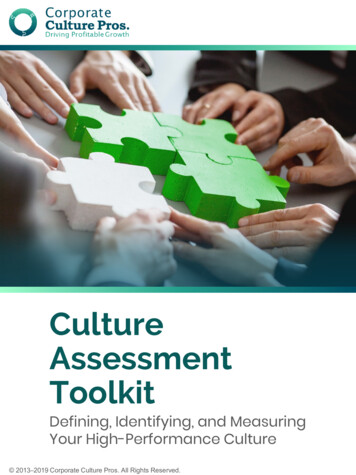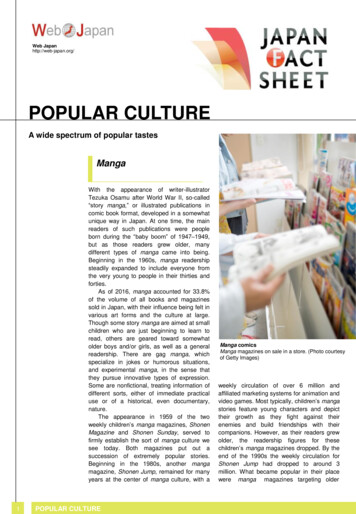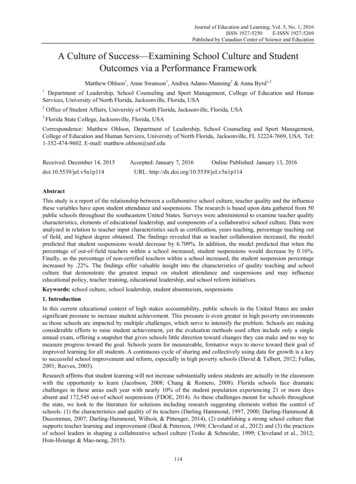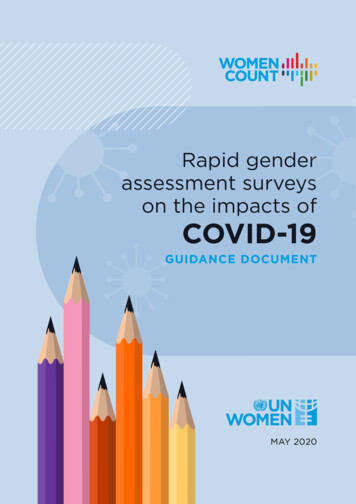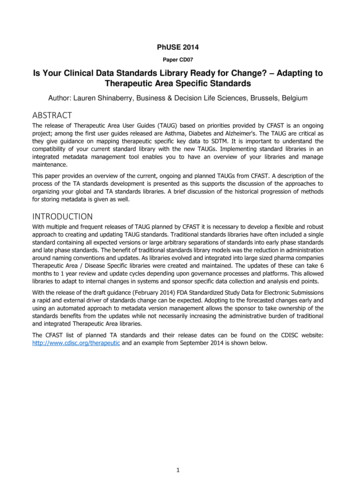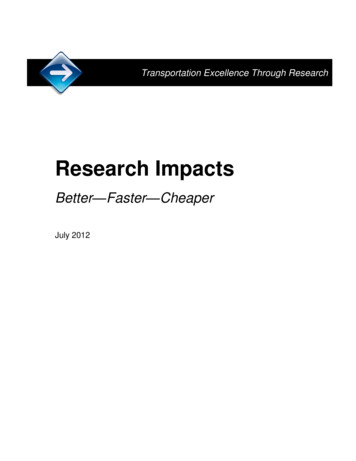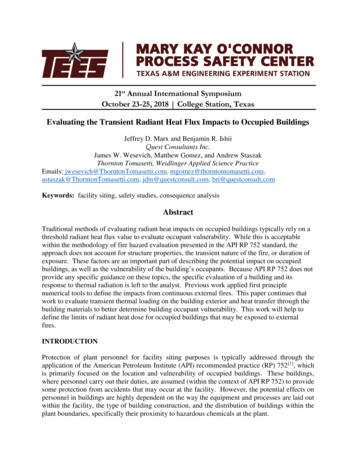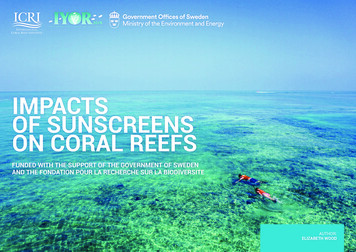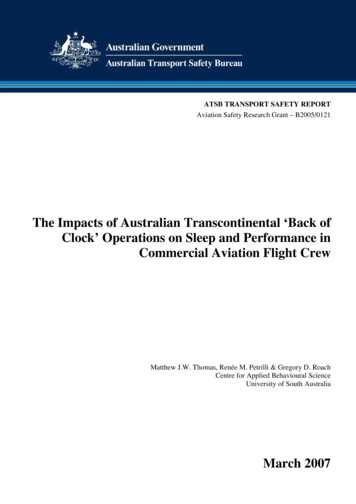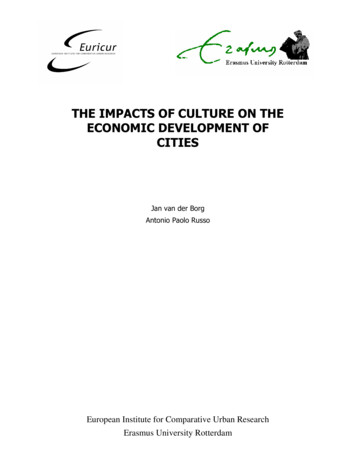
Transcription
THE IMPACTS OF CULTURE ON THEECONOMIC DEVELOPMENT OFCITIESJan van der BorgAntonio Paolo RussoEuropean Institute for Comparative Urban ResearchErasmus University Rotterdam
The Impacts of Culture onthe Economic Developmentof CitiesA research into the cultural economies and policies ofAmsterdam, Bolzano, Edinburgh, Eindhoven, Klaipeda,Manchester, Rotterdam, Tampere, The Hague andViennaDRAFTSeptember 2005J. VAN DER BORGA.P. RUSSOAssisted by:M. LavangaG. MingardoEuropean Institute for Comparative Urban Research (EURICUR)Erasmus University Rotterdam
TABLE OF CONTENTSPREFACE1EXECUTIVE SUMMARY31.72.INTRODUCTION1.1.Research background71.2.Objectives of this project and research questions91.3.Working definitions101.4.Research methodology and project output13CULTURE AND CITY: THE RESEARCH CONTEXT162.1.The urban life-cycle and the “knowledge economy”162.2.Culture and urban development193. A MODEL OF CULTURE-ORIENTED ECONOMIC DEVELOPMENT(COED) FOR THE CITY224.5.3.1.The “urban cultural cluster”233.2.Evolution of the cluster233.3.The economic impacts of culture263.4.The cultural cluster and the socio-environmental fabric of the city 293.5.Integrating three impact areas in one model frameworkCOMPARATIVE ANALYSIS OF TEN CASE STUDIES31354.1.Main city characteristics and European positioning354.2.Cultural highlights374.3.Size of cultural sector434.4.Spatial organisation and structure of the cultural sector474.5.Integration with the urban economy534.6.Sustainable development of the cluster60POLICY RECOMMENDATIONS AND FINAL REMARKS685.1.Testing the viability of the COED model and benchmarking685.2.Policy frameworks and recommendations715.3.Final remarks87REFERENCES89
ANNEX: THE CASE STUDIES1CASE STUDY OF AMSTERDAM2CASE STUDY OF BOLZANO, ITALY1313CASE STUDY OF EDINBURGH1534CASE STUDY OF EINDHOVEN1935CASE STUDY OF KLAIPEDA2176CASE STUDY OF MANCHESTER2477CASE STUDY OF ROTTERDAM2778CASE STUDY OF TAMPERE3039CASE STUDY OF THE HAGUE33710 CASE STUDY OF VIENNA95359
PREFACEThe present topic has first been proposed to become a EURICUR researchduring a dedicated workshop of the 2001 EUROCITIES General Meeting inBarcelona, by initiative of the Economic Development and Urban RenewalCommittee (EDURC), at that moment chaired by the City of The Hague.It has since then slowly evolved into a full research programme with, in thetradition of EURICUR research, as many as ten partner cities that individuallyfunded the project and served as case studies for the investigation. The Cityof The Hague has facilitated the creation of the city network and maintainedthe leadership of this network during the project.Fortunately, the study of cultural issues was not new to EURICUR. A soundbase of theoretical work and comparative research in related fields such ascultural tourism, culture and heritage planning, economic clusters, and theknowledge-based economy could be built upon. In reality, treating cultureand creativity as economic engines for urban areas and applying EURICUR’spolicy-oriented research approach to a field that today has deserved a veryhigh position on cities’ agendas, proved to be a tough challenge.Nevertheless, the authors hope that the timing is appreciated, not onlybecause academic work regarding the economic impact of culture is in fulldevelopment, but also because empirical work is still extremely scarce andespecially this knowledge proves to be essential for urban policy.The project has been organised and conducted by a EURICUR team consistingof Jan van der Borg and Antonio Russo. Mariangela Lavanga and GiulianoMingardo have assisted in the writing of a number of case studies(respectively Amsterdam, Edinburgh, Klaipeda and Tampere, and Rotterdam,The Hague and Eindhoven). Moreover, we are grateful with the late KlausSchussmann for having started this debate and bringing it to the attention offellow policymakers, and to Paul Zoutendijk for building the network ofpartner cities that supported the project. Finally, our appreciation goes to allthe city representatives that participated in this study and assisted us in theorganisation of field trips and data collection, and to all the people that wehave interviewed; their names are listed at the end of the single case studies.
2
EXECUTIVE SUMMARYThe present report is the result of an international research by EURICUR, theEuropean Institute for Comparative Urban Research, based at the ErasmusUniversity Rotterdam. Ten cities have associated in this research, acting bothas funding partners and case studies: Amsterdam, Bolzano, Edinburgh,Eindhoven, Klaipeda, Manchester, Rotterdam, Tampere, The Hague, Vienna.The City of Hague is the leader of the network and has been the initiator ofthis research project.The project focuses on the conceptualisation and analysis of the effects ofculture on the economic development trajectories of European cities. It movesfrom the recognition that culture is a key ingredient of post-industrial,information-intensive economic activity. A culture-oriented economicdevelopment is one that integrates the symbolic and creative elements intoany aspect of the urban economy, pursuing distinction, innovativeness, and ahigher level of interaction between localised individual and social knowledgeand globalising markets.Presently, cities spend more and more in cultural programmes as well as largeinfrastructure projects, which are supposed to be drivers of sustainabledevelopment: urban landmarks influencing the image and the attractivenessof the city for private investments, but also platforms for the “new creativeclass” and stimuli to social integration through self-reflection and culturalinclusion. However, there is uncertainty with regard to the type andmagnitude of returns expected from such projects. Moreover, seed-fundingcreativity and cultural dynamism is a complex issue, as traditional institutionsand policy approaches are hardly able to come to terms with fuzzy, anarchistsocial structures.This EURICUR study sets out to propose a theoretical framework to interpretand possibly steer culture-oriented urban development: the COED model.From the development of a cluster of cultural activities, all types of economicand social externalities arise, in a self-reinforcing process. Policy has toaccompany this development caring that the condition that are necessary forthe vitality of the cultural sector and ultimately for the endurance of thismodel are maintained in time: spatial balance, social mobility and access tocultural resources, but also networking and cross-fertilisation within thecluster and at its edges.The comparative analysis of the ten case studies – ranging in size andEuropean positioning from full-blown European capitals to medium-sizedheritage cities and cities in economic transition – confirms some of theintuitions of the COED model. In cities where a certain number of “culturalclusters” have emerged, the urban economy has been structurally modifiedtowards the symbolic. Cultural clusters have become – to varying extents,according to the characteristics, location and governance structures of suchclusters – catalysts of a wholesome creative economy, involving a higherattractiveness for tourists, skilled talents, and ultimately for knowledge3
intensive enterprises in search of an innovative climate and high levels ofquality of life. Indeed, contemporary skilled workers attach a high value to astimulating cultural climate and communities open to the new and symbolic;these factors come to influence their mobility choices, and ultimately, thecompetitiveness of a city.However, culture-oriented economic development is subject to strongendogeneity, modifying continuously the original conditions that make placesculturally rich and viable as creative hubs. Thus COED is potentially shortlived and may bring to irreversible changes in the urban environment: theerosion of social capital, the dispersion in space of cultural activities and theconsequent decreasing of clustering effects, and ultimately the fading of localcultural identity and “uniqueness”. Urban policy should be careful toaccompany the COED process making sure that these limits are neverreached. Physical and cultural planning, social and educational policies,infrastructure projects and the implementation of innovative forms ofgovernance and networking may achieve these objectives, but the policycontext is made fuzzier and more complex by the unconventional nature ofeconomic and social processes underlying cultural activities and creativeproduction.The ten cities have been assessed and benchmarked against the developmentof this model. We find that some cities have progressed more than others todevelop their cultural sectors into full catalysts for economic growth, in somecases (Amsterdam, Manchester) the limits which would modify the conditionsfor sustainable development are close: gentrification and changes in socialmix, loss of spatial centrality in creative production sectors, lack of alternativedevelopment locations, erosion of cultural identity and character. In Viennasuch limits do not appear to be a threat in the short period, though the citystill needs to strengthen and diversify its cultural industries to positivelyinfluence a wider range of growth sectors. In other cities like Rotterdam,Eindhoven, Edinburgh, The Hague, COED has been limited to internal growthof a limited number of cultural sectors and clusters, missing to affectsubstantially the development opportunities for other economic sectors byinfluencing their innovativeness and location potentials. Finally, another groupof cities, namely Tampere, Bolzano, Klaipeda, are still at the starting stages oftheir cultural clustering process and are negatively affected by their relativelack of accessibility and mass. The development and support to selectedcultural production sectors (gaming and multimedia in Tampere, visual artand music in Klaipeda, music and performing arts in Bolzano) could result in amore high-quality, knowledge-intensive environment but policy need to steerthis process in a more radical way.A number of policy recommendations for a sustained COED leading toincreased urban competitiveness as well as plenty of illustrations from bestpractices and common mistakes are given. Funding schemes for culturalactivity are taken into consideration, like Amsterdam and its four-year subsidyplans as an interesting method to stimulate a strategic attitude in arts andculture; then we turn to support to cultural and creative industries, where the4
template is undoubtedly Manchester and its policy to develop creativeenterprises turning social idiosyncrasy into a growth sector for the city. In thefield of social policy and education, we illustrate various examples of projectsof social inclusion through cultural education and programming. Culturalplanning regards the integration of culture in urban management. Edinburgh’sstrategic documents for the cultural sectors or Amsterdam’s kunstenplan aregood examples of cultital policy agendas that do not stop at the boundaries ofart and culture but have the ambitions to become levers for generalised urbandevelopment. As far as infrastructure policy is concerned, we try to evaluatehow far “cultural flagships” like Rotterdam’s waterfront redevelopment orVienna’s MuseumQuartier have resulted in a more viable cultural climate, andwhether traditional infrastructure works, enhancing accessibility, safety,hospitality, may achieve similar results; finally we discuss innovativenetworking arrangements and governance models, looking at interestinginitiatives taken in many cities in our study.5
6
1. INTRODUCTION1.1. Research backgroundCulture counts. And today more than ever, it counts for cities, thepowerhouses of the contemporary society. Culture is a full-fledged economicsector that – as any other – generates impacts on the urban environment,ranging from direct and indirect expenditure to employment generation.Cultural industries are typically labour-intensive; their organisation model israther the network interaction of micro and small producers than the supplychain hierarchy of Fordist industries. Moreover, cultural production is highlycontextual and idiosyncratic. For these reasons, city centres are privilegedspaces for cultural production and consumption (Scott 2001, Heilbrun 1992).Cities provide ideal workspace for artists and cultural managers; and the localeconomy comes to thrive of it, establishing a symbiotic relation with culture.Firstly, culture generates substantial “intangible” or non-pecuniary economiceffects. It has a soft function of animation and enhancement of the quality oflife, which is an increasingly important element of a city’s competitiveness. Itstimulates human creativity, and the capacity to innovate. New symbolicmeanings and values become inputs to innovative production concepts andprocesses. A city can market itself as an ideal location for people and firms,and a preferred cultural destination for tourists; its unique, original culturalmix can become a recognisable brand (New York’s loft living, Berlin’sunderground art, the Bristol sound, etc.).Furthermore, culture may contribute to a more balanced and sustainableurban development. Culture is part and parcel of urban revitalisation projectsin degraded urban areas throughout the developed world. It provides aformidable opportunity for personal development and social interactionamong weaker groups, and gives to “excluded” individuals a chance to theirown start businesses or to catch up socially.The relation between a community and its culture extends to concerns ofsafety and social harmony. In an age in which societies tend to become multicultural, identities and ways of life confront one another. In the multi-culturalcity, culture can be a lever that stimulates pride, personal development, andself-fulfilment for minorities, and at the same time it can be a commonlanguage, a bridge between different groups. For this reason culturaldevelopment and planning are regarded as valuable strategies to accelerateprocesses of urban growth or regeneration. Cities invest in cultural facilitiesand events, and in the preservation of their historical heritage, to make theirtransition to a post-industrial economy based on advanced services,sustainable functional mixes, and a high quality of the urban environment.This means that policymakers and elected politicians have to get the wholepicture of the relevance of culture as an economic asset for the city, seewhere the problems are, and in which ways the synergies between culturaldevelopment and local economy can be activated and boosted. This is clearly7
not just information regarding the cultural sector of a city, which by the wayreceives surprisingly little attention by most municipal administrationsthroughout Europe. Clear knowledge of the effects of culture on otherfunctions of the city is also needed, from the economic field to social andcultural considerations.Today we dispose of a substantial body of literature on the relationshipbetween culture and the city. In particular, works like “The creative city” by C.Landry, “The cultural economy of cities” by A.J. Scott, and “The rise ofcreative class” by R. Florida, lay the foundations of a new way of thinkingabout the interrelationship between culture and place. Culture is seen in theseworks as a “way of doing” which is typical of a particular location, determininga comparative advantage in the production of specialised goods and services.This conceptualisation of culture as “system of social norms” informs the webof strategic relations (production or personal) which comes as part and parcelof modern forms of organisation of the economy. Florida (2000) argues thatin the global economy the communication skills of the members of the“creative class” make the strength of the local milieu. Culture alsorestructures the governance of local growth processes: according to Landry(2001), the governance of a highly dynamic, complex, flexible and creativesociety also has to have creative and “lateral” qualities. Finally, Allen J. Scott(2001) shifts the discussion to culture as an urban “product”, or a set ofindustries that find their natural environment in cities, occupying a centralrole in regeneration processes, and generating value by feeding globalfunctions dependent on image creation and valuation (tourism, infotainment,media, etc.).Though rich and path-breaking, this debate is still decidedly “culture-centred”.The starting point is culture, and the way it gets embedded in advancedcapitalistic forms. The main result is that cities are special places for this“encounter”. However, so far, little progress has been made in passing fromabstract reflection to know-how that should orient the action of policymakers, both at local and European level. One main reason for this is thedifficulty of defining and delimiting culture, given the complexity of thecultural production and consumption processes, and the heterogeneity of theplayers involved. In short, the European policy agenda is not yet ready tomeet the challenges from a “stealth” area of urban development.We wish to turn the question upside down and start from cities, their presentpositions and their chances of developing in a new, (more) sustainable way.The implications of the new “cultural economic” paradigm for urbandevelopment in terms of opportunities and threats have yet to be explored indeep, starting from this promising basis and integrating it with the traditionaland most recent ideas in the field of urban economic planning.8
1.2. Objectives of this project and research questionsWhat is the contribution of a stimulating cultural environment to the locationdecisions of firms? What is the participation of citizens and tourists to art andculture? How are urban land values influenced by proximity with culturalattractions? What is the status of artists in the city, and what is their level ofinteraction with corporations? Are innovative businesses exchanging ideaswith art organisations and creative talents? Where are cultural organisationslocated? Are they segregated, unable to reach wide audiences? Do theyreceive enough attention, public investment and private sponsoring?These questions are the key to understand the role of culture and enhance it,for the well-being of host communities. Unfortunately, it is very hard toprovide sound answers, because they mainly regard qualitative informationwith strong contextual and historical character.The formulation of a consistent and effective urban policy agenda addressingculture requires more knowledge on the processes and impacts generated byculture in the city, and on the tools that may bring forward positive synergiesbetween cultural development and other sectors of the urban arena.Recent research on the cultural economic of cities has polarised between theanalysis of prevailing trends and development models (Scott, 2000) and analmost frantic activity of data collection and elaboration on the other,reflecting an urge to re-assess the importance of cultural activities as growthsectors. Little attention has been paid, instead, to the analysis of urbanimpacts (with notable exceptions, for instance the European projectEurocult21: www.eurocult21.org) with the consequence that data collected indifferent cities are inconsistent or incomparable, and that the policy makersdo not really know what use can be done of these data to justify developmentprograms. In particular, raw cultural industry data can hardly be used todefend public or attract private investments, as more often than not theyportray weak, fragile and fragmented sectors, while the heritage industry isoften seen as “non rentable”, which – abiding strict economic principles –would play against conservation.However, the integration of culture in urban studies promises to revealinterdependencies which can hardly be limited to the financial sphere, andcan be grasped only by multi-criteria analysis.This projects aims at understanding these interdependencies, and atintegrating them in a methodological framework that could be usedby scientists and policymakers to assess the impacts of culture onthe economic development of cities.In particular we would like to address the following issues:o What is the “cultware” of a city, that is, how can a city be described interms of its historical identity, cultural heritage and traditions, placedistinctiveness, current cultural production activities and creativecapacity?9
o What are the structure and the dynamics of the relations between thedifferent components of the cultware?o What kind of impacts and mutual influence can be expected fromcultural activities and investments on the current and future social andeconomic development trends?o What are the inner dynamics of the cultural production sector? Howdoes the cultware evolve and gets articulated in the fabric of the city?o What is the scope for policy and the available tools to steer thedevelopment of the cultware in the desired direction?1.3. Working definitionsThorough analytic research on the impacts of culture risks to be hampered bythe lack (or complexity) of such concepts as “culture” and “art”. The veryboundaries of the definitions of culture are shifting all the time, as are thearchitecture of symbols and meanings that underpins the structure of oursociety. The emergence of the “knowledge-economy” as the main productionand value-generation paradigm of our age impinges at strongly culturalelementTo master the very notion of culture is by no means easy. Definitionaldifficulties proved a major obstacle in efforts to streamline the informationregarding the economic impacts of culture and propose a widely acceptedassessment methodology. In its most general and philosophic terms, culturecan be seen as a shared way of doing and understanding things, a system ofvalues and an aesthetic language that binds a community and is formed bythe peculiar historical development of that community. At the worldconference of cultural politics in Mexico City in 1982, UNESCO describedculture as concerning « all the specific features, spiritual, material,intellectual or affective, that characterise a society or human group. Cultureincludes, besides art and literature, way of life, basic human rights, system ofvalue, tradition and religions». Though in the global world the information –and therefore the means to understand reality – are converging more andmore, cultures still make a difference, and in this sense we Europeans can saythat we are different from Americans, Italians claim they are different fromGermans, and even Rotterdammers may vindicate their exclusive “know how”distinguishing them from the other Dutch.Culture is what characterises us as human beings and members of acommunity. However, this general, transcendental meaning of culture is itselfthe reflection of cultural activity, that is, the way in which artists and creativethinkers have read and described reality, providing their fellow citizens withan “interpretation code”. Through human creative activity, culture isaccumulated, experienced and rooted in the DNA of a community, not only astangible items like monuments and art objects, but also as symbols, activities,10
landscapes or landmarks, traditions of public life and conviviality, festivals,rituals, food.In addition to the difficulties in rendering the abstract definition of culturemore operational, its meaning changes from place to place and over timeaccording to the prevailing cultural paradigms. The distinction between “highbrow” culture and “popular” culture, inherited from the Victorian times, isfading in the present cultural discourse, though conventionally there is talk of“serious art” in reference to theatre and ballet performances, classical musicand visual arts. The search for unfamiliar expressions of culture and theendeavour to explore its economic value enlarged the meanings of culture asa product1.In this work we are not interested in semantics or in an original definition ofwhat is culture, though we are aware of the complexity and relevance of thedebate. We are rather concerned with the analysis of the effects that culturalactivities as commonly accounted for have on the patterns of economicdevelopment of cities. Through time, two fields of analysis have becomecommonly accepted in the academic world: culture as a product, which raisesrelevant questions regarding the production, the consumption and theeconomic value of culture, as well as the instrumental use of culture as a toolfor urban regeneration and place marketing; and culture as a process, whichhints at creative thinking leading to distinctive patterns of social organisationand economic growth (Lavanga 2002). The first category involves moreclosely the tangible elements of culture, the second its intangible aspects.A complex set of activities and actors with utterly diverse characteristics,functions and objectives are generally included in accounts of the culturalsector. Cultural and art organisations are characterised for their specificproducts: they focus on the «production and distribution of goods andservices of artistic and cultural nature, and can be classified in many ways»(Guerzoni, 1998, p. 241). The identification of what is meant by culturalactivity or production leads to the delimitation of the set of actors thatconstitute the “cultural sector”. All the goods and services characterised bythe following qualities can be included in this set: i) uniqueness ii) scarcity iii)idiosyncrasy in production iv) heterogeneity v) low grade of use value vi)aesthetic and semiotic content (symbolic attributes) vii) low grade of technicalreproducibility viii) simultaneity between production and consumption.Though this is particularly evident in the case of museum institutions, culturalorganisations are characterised by the fact of managing a complex supply,combining the capacity to preserve culture (for the enjoyment and educationof the future generation) with the provision of services for the access and1The controversial but very successful exhibition “Trash Culture: the Potholes of Taste” hasbeen recently organised by the Centre for Contemporary Culture in Barcelona. According tothe organisers, «the products of trash culture are those that “official” culture brands asaberrant, but which the consumer, by means of irony, can elevate to the category offascinating.» (www.cccb.org). Hence, a cultural attitude – irony – redefined the boundaries ofwhat is culture or even art and what is not.11
fruition of cultural products (e.g. exhibition to the public) that augment theirvalue. However the most fundamental task of cultural organisations is to bethe herald of symbolic meaning towards the community of users, theinterlocutor to an audience creating and proposing a culture experience,favouring the interaction between audience and works of art. In thisperspective, cultural organisations are at the crossroads between authors andartists and their public, between the public and the private realm, within theframework determined by the local society and the territory.In this project, “culture” is to be conceived in a broad sense as “culturalactivities” (including the activity of cultural organisations, heritageconservators and managers, the organisation of events and the operation ofcreative industries), following the working definition endorsed by the CulturalCommittee of EUROCITIES in the Policy Document «The cultural dimensionsof urban governance». As any other field of human activity, cultural activitiescan get organised in particular models of interaction of different individualsand organisations (cultural industries); as such, it is subject to economicassessment (creation and distribution of value).According to the definition of culture that Member States agreed upon at theclose of the LEG EUROSTAT proceeding2, activities incorporated withincultural policy are those dealing with the conservation, creation/production,dissemination and trading, as well as education, in all cultural goods andservices in the following domains:ooooooooCultural HeritageVisual ArtsArchitectureArchivesLibrariesBooks and PressPerforming ArtsAudio and Audiovisual Multimedia.Activities which cross-cut all or some of these domains will also be included,like the building or management of cultural centres, the support for culturalassociations, the promotion of national cultures abroad so on. These subsectors are incorporated within an additional inter-disciplinary domain. Thissaid, we include among cultural activities the following entities:2EUROSTAT, Cultural Statistics in the EU – Final Report of the LEG, Luxembourg 200012
Organisations and institutions that produce, organise and promote culturalgoods and services:Performing arts. Theatres and lyrical companies; open-air theatres and arenas;orchestras and music bands; theatre, song & dance companies; circuses and travellingshows.Visual arts. Museums and exhibition centres; galleries, antiques shops and auctionhouses.Heritage management and conservation. Theme parks and historical sites; heritagecompounds and cultural routes; historical buildings and mansions; parks and botanicalgardens; zoological and marine gardens, aquariums and eco-museums; churches,abbeys, monasteries, sanctuaries and other worship sites; archaeological andmonumental sites.Cultural events. Various festivals; historical celebrations; fairs and expos; concerts;temporary exhibitions; sport events.Other cultural / creative industries. Entertainment; radio and TV industry; movies,music recording, cultural tourism (e.g. tourist guides); sport organisations; press andpublishing; multimedia.Organisations and institutions that enhance cultural comprehension and taste,stimulate creativity, develop interpretative capacity:Higher education. Universities, academies, colleges.Documentation centres. Libraries, archives, data bank
2.1. The urban life-cycle and the “knowledge economy” 16 2.2. Culture and urban development 19 3. A MODEL OF CULTURE-ORIENTED ECONOMIC DEVELOPMENT (COED) FOR THE CITY 22 3.1. The “urban cultural cluster” 23 3.2. Evolution of th
